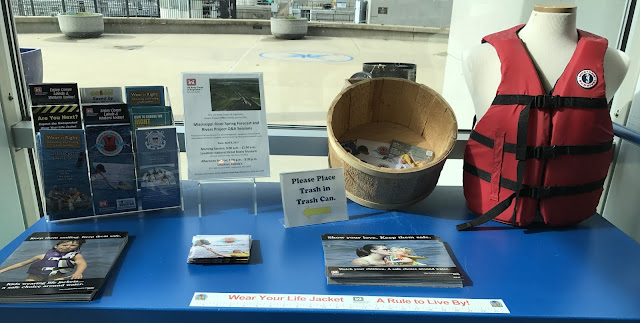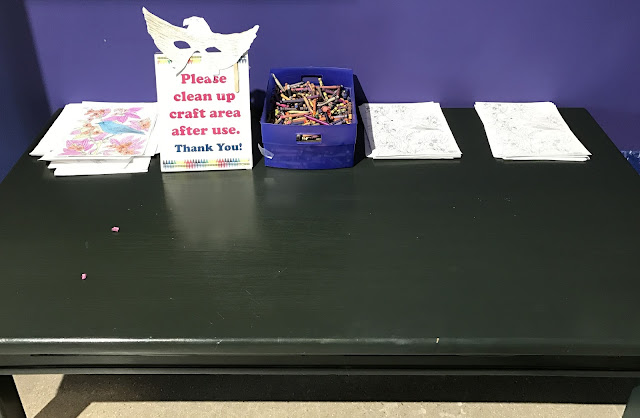Alton, Illinois 62024
Free admission and free parking
http://www.meetingoftherivers.org/
The Melvin Price Locks & Dam, seen on the left below, behind the museum building, are owned by the Corps of Engineers and were completed in 1994 after 16 years of construction. The Meeting of the Rivers Foundation built the National Great Rivers Museum on the land next to the locks. It opened in 2003.
As you approach the museum, a large model of the Mississippi River greets you. Unfortunately we visited in early spring before the model was filled with water.
The museum is basically one large room with a wall of windows looking out onto the locks, dam, and river. According to the website the museum is divided into 15 exhibits.
Our River: This exhibit greets you as you enter.
Communities: Habitats of Missouri: The three main ecozones are the river, the floodplains, and the bluffs shown in the exhibit below.
The floodplains exhibit also includes animals and many cards of information.
This other display about the bluffs includes four interactive activities.
Visitors may open the lids to listen, touch, or look.
Yes, you can touch the turtle shell!
Mississippi in Motion: The five cycles - geological, annual, seasonal, monthly, and daily are shown on the screens. By working a button, visitors can determine the speed of the videos enabling you to watch changes very quickly or slowly.
Confluence Map:shows the confluence of the Mississippi, Missouri, and Illinois Rivers.
Open the four lids to learn more about the area.
River Timeline: a 60-foot wall display presenting the history of the Mississippi River from prehistory to today.
Stairway for Boats: this exhibit allows visitors to practice controlling the water through the locks! We found this very challenging at first.
This exhibit shows that these barges coming down the river carry mostly grain, coal, and domestic petroleum.
Steer the barge: another visitor challenge.
Not as easy as it looks - we crashed the barge!
Learning more about barges.
Aquarium: There actually are Jurassic fish in the museum aquarium. And in the River!
Moving Water: The River flows for 2,320 miles.
A stream table allows you to see how a riverbed may change due to flowing water.
Micromodel and Sediment Interactive: learn how micromodeling is used in river management.
This display allows visitors to stir up the sediment and watch how it settles.
Three other areas are titled: Surf the Watershed; Common Water, Common Ground; and What Makes a Great River.
The museum has other isolated displays including this one about workers associated with the river. Note the video in the display.
This large model of the Horatio G. Wright snagboat was built in 1904 for the St. Louis Worlds Fair. The boat itself was built by the Corps in 1880 to clean the river bottom in order to deter damage to steamboats from trees and stumps hidden under the water.
We saw the 28-minute Power of the River that was about the Mississippi and very well done.
In addition to all of the interactive displays, there are a few tables set aside for activities for families and young children.
The majority of the gift shop is centered around items for children, with some excellent nature-oriented books. And yes, those are stuffed catfish in the bottom left wooden crates.
Melvin Price Lock and Dam: This display shows that there are 29 locks on the Mississippi with this one being the second to last. This was the last one built.
Each year more than 75 million tons of goods, valued in excess of $23 billion move through these locks.
Here you are looking north.
Here you are looking south. To the right is the runway barge protection cell and on the other side of the far right wall is the 1200-ft. main lock used for large commercial tows. The length of the main lock and guidewalls is 3/4 mile. As many as 15 barges can move together with one tugboat through the lock.
The width of the dam is 1160 feet - almost 4 football fields. We did not walk the entire length but only went as far as the control tower shown on the right. Spools of cable are kept on top so to be available when needed for repair.
The control tower has an operator on duty 24/7. The tour normally includes visiting the old control room but the elevator to it was not working so we were unable to see it.
There are a few informative murals on the tour such as these two.
For lunch we drove north on the Great River Road, following the Mississippi River for 20 miles to Pere Marquette Lodge. The lodge was built of limestone and timbers by the Civilian Conservation Corps during the Great Depression, 1933-1939.
A view of the River from behind the lodge.
The VERY TALL Lodge Club Sandwich with soup.
The QUITE LARGE Fern Hollow Chef Salad.
Comments: Visiting this museum, one can learn a great deal about the Mississippi River in particular and rivers in general.
A plus for the museum is the large number of interactive displays. The museum is not particularly high tech but it has a lot of activities most ages can do. There appears to be no set path for seeing all of the displays so we tended to wander some and frankly I think I missed seeing a few of the exhibits. Overall it was definitely worth going to visit.
I had heard from friends wonderful things about the 45-60-minute tour of the locks. We went on a windy day and the guide indicated he would do a shorter tour and it was shorter. Plus we did not get to see the old control room because the guide could not get that elevator to work. There was a lot of information that we expected to hear on the tour that we did not. The guides are volunteers and I am sure some are better than others. Our guide was nice but he seemed very interested in telling us about other places to visit in the area and less about the locks themselves. He did not answer all of our questions. I picked up a brochure that informed me of many interesting facts that really should have been included in our tour. I am glad to have had the experience of being on top of the dam and seeing it all, but it would have been nice to have had a more informative guide.
I called ahead to make sure that we could tour the locks on the date we chose. The first time we called in 2016, we learned that there was a lock broken and that tours were cancelled for several weeks. When I called this time I made sure, also, that there were no school field trips scheduled at the time we planned to come as they get very busy in the spring with school groups. If your group size is under ten you can not make reservations so the museum employee I talked to suggested we come early and sign up so that we could be sure to make the tour. As it turns out the museum had few visitors and only a lone man did the tour with us. We arrived at 9:15, signed up for the 10:00 tour and visited the museum in that 45 minutes. After the tour we watched the film.
The restaurant that we had chosen for lunch, Fast Eddie's, doesn't open until 1:00 on weekdays, so we ended up having to pick a different place for lunch. There appear to be many wonderful choices between Alton, Grafton, and Elsah, but we decided to go the extra distance to Pere Marquette and it was worth it. The menu was great with lots of choices and the food was excellent. We were served large servings for under $10.00. The lodge is part of a conference center and the restaurant serves breakfast, lunch, and dinner every day. We were almost the only ones in this very large dining hall and we enjoyed visiting with no competing noise. It was definitely a relaxing atmosphere.




















































